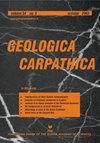Tatric地区Nízke-Tatry Mts.的变形记录和修正构造演化 – Veporic交界区:结构分析的见解
IF 1.5
4区 地球科学
Q4 GEOSCIENCES, MULTIDISCIPLINARY
引用次数: 0
摘要
当前位置Nízke塔特里山是位于西喀尔巴阡山脉中部的山脉。纵观历史,所研究的地区至少受到两个造山旋回的影响——瓦里斯坎和阿尔卑斯。基于结构分析,可以确定几个变形事件。伴随Variscan期高变质作用的较老变形(dv)以片岩带、片麻岩带等渗透构造片理为特征,与褶皱、线理相辅相成。相比之下,较年轻的变形(da)以低等级(逆行)变质作用、千粒叶理作用、粒粒叶理作用、碎裂作用和少量再结晶作用下的构造演化为标志。瓦里斯坎变形(d2v)是最早的普遍变形,s2v变质片理演化明显,局部保存着s1v平面构造的等斜和无根褶皱。拉伸和矿物线理(l2v)通常面向ENE-WSW方向。d2v的结构受到褶皱(f3v)的强烈影响,在许多地方,以s3v轴向平面的发展为标志。高寒变形(d1 A)伴低级变质作用,在部分地区表现为空间至地带性的普遍叶理作用(s1 A)。这种变形的特征是一个典型的碎粒解理,其中s2v面被折叠并产生s1a片理。砾岩和交点线(l1 cA)呈NE-SW - E-W走向。d1 A变形还伴随着明显的NNW-SSE槽演化、拉伸和矿物线理(l1ta)。NNW-SSE方向的缩短也表现为不对称褶皱,褶皱轴(f1 A)和线相交(l1 cA)方向为ENE-WSW方向,具有明显的顶部- nnw构造搬运。观测到的最年轻的阿尔卑斯变形(d2 A)与在间隔平面结构(s2 A)上由阿尔卑斯线(l2 A)定义的由顶向东移动的太古晶体基底的延伸有关,并对应于C面。本文章由计算机程序翻译,如有差异,请以英文原文为准。
Deformation record and revised tectonic evolution of the Nízke Tatry Mts. in the Tatric – Veporic junction area: Insights from structural analysis
: The Nízke Tatry Mts. is a mountain range located in the central part of the Western Carpathians. Throughout history, the studied area has been affected by at least two orogenetic cycles – Variscan and Alpine. Based on structural analyses, it is possible to determine several deformation events. The older deformations ( D V ), which were accompanied by the Variscan higher-grade metamorphism, are characterised by penetrative tectonic foliations, such as schistosity and gneissic banding, and go hand in hand with folds and lineations. In contrast, the younger deformations ( D A ) are marked by structural evolution under low-grade (retrograde) metamorphism, phyllitic foliations, crenulation foliation, cataclasis, and minor recrystallisation. The Variscan deformation ( D 2 V ) is the earliest pervasive deformation with pronounced evolution of S 2 V metamorphic foliation, locally with preserved isoclinal and rootless folds of S 1 V planar fabric. Stretching and mineral lineations ( L 2 V ) are usually oriented in the ENE–WSW direction. The fabric of D 2 V is intensively affected by folds ( F 3 V ) and, in many places, marked by development of S 3 V axial planes. The Alpine deformation ( D 1 A ) was accompanied by low-grade metamorphism and depicted by space to zonal with pervasive foliation ( S 1 A ) in some areas. This deformation is characterised by a typical crenulation cleavage, where S 2 V planes are folded and produced S 1 A foliation. The crenulation and intersection lineations ( L 1 cA ) have NE–SW to E–W trends. The D 1 A deformation is also accompanied by pronounced evolution of NNW–SSE groove, stretching, and mineral lineation ( L 1 tA ). Shortening in the NNW–SSE direction is also evidenced by asymmetric folds with an ENE–WSW orientation of fold axes ( F 1 A ) and line intersections ( L 1 cA ) with pronounced top-to-the-NNW tectonic transport. The youngest observed Alpine deformation ( D 2 A ) is related to an extension of the Tatric crystalline basement with top-to-the-east transport defined by Alpine lineations ( L 2 A ) on spaced planar structures ( S 2 A ) and correspond to C surfaces.
求助全文
通过发布文献求助,成功后即可免费获取论文全文。
去求助
来源期刊

Geologica Carpathica
地学-地球科学综合
CiteScore
2.40
自引率
23.10%
发文量
26
审稿时长
>12 weeks
期刊介绍:
GEOLOGICA CARPATHICA covers a wide spectrum of geological disciplines including geodynamics, tectonics and structural geology, volcanology, stratigraphy, geochronology and isotopic geology, karstology, geochemistry, mineralogy, petrology, lithology and sedimentology, paleogeography, paleoecology, paleobiology and paleontology, paleomagnetism, magnetostratigraphy and other branches of applied geophysics, economic and environmental geology, experimental and theoretical geoscientific studies. Geologica Carpathica , with its 60 year old tradition, presents high-quality research papers devoted to all aspects not only of the Alpine-Carpathian-Balkanian geoscience but also with adjacent regions originated from the Mediterranean Tethys and its continental foreland. Geologica Carpathica is an Official Journal of the Carpathian-Balkan Geological Association.
 求助内容:
求助内容: 应助结果提醒方式:
应助结果提醒方式:


